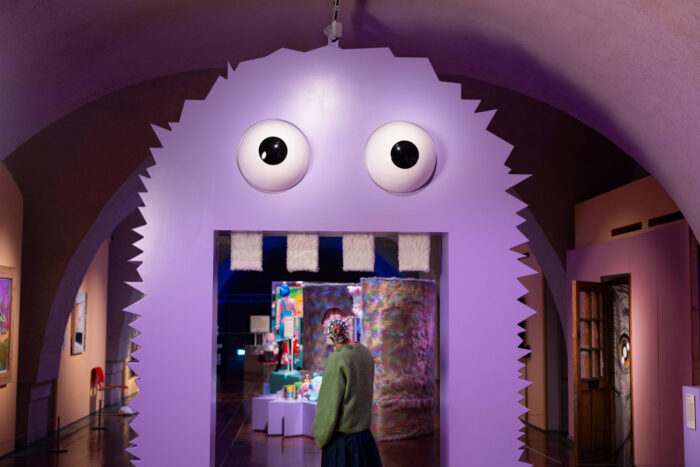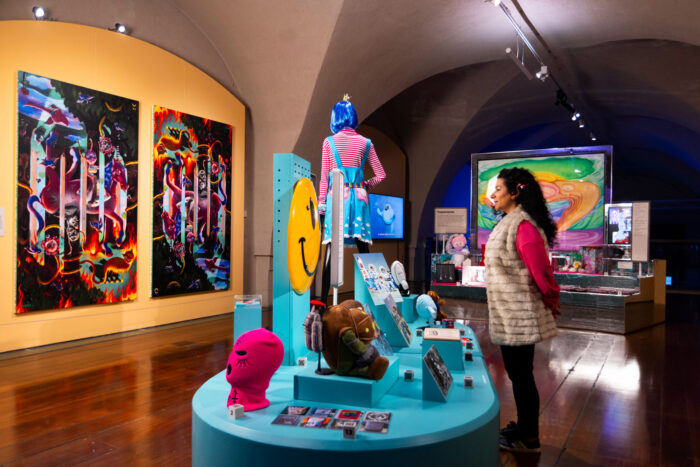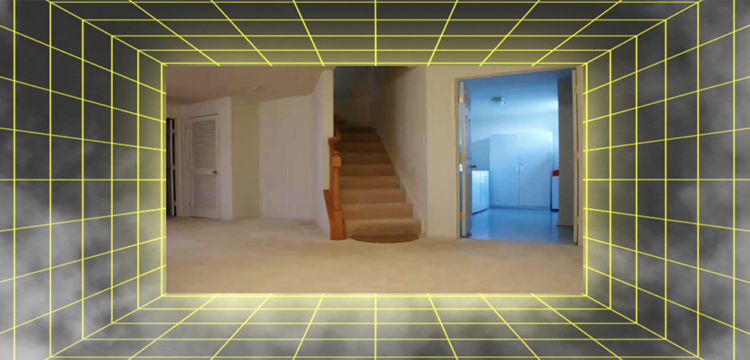Kittens Rule Over The World
On the radicality of cuteness
From pop culture to artistic production, CUTE, a new exhibition at Somerset House in London, explores the cutification of today’s aesthetics. Tracing back its origins and overseeing its broad expressions and sociological value, the show articulates how cuteness became one of contemporary culture’s most influential and powerful drives.
When Tim Berners-Lee, the creator of the World Wide Web, was questioned about an unforeseen use of the Internet, he responded in a single word: “Kittens.” From social media memes to stickers, emojis, and gifs, the cats—alongside capybaras, racoons, and dogs alike—have unexpectedly risen to assume the role of unofficial custodians of the digital realm. “[Cuteness] saturates everything in the post-internet age, and its everyday ubiquity is only intensified by its superficially unthreatening and sometimes pitiable nature,” says Claire Catterall, curator of CUTE, a new exhibition at Somerset House in London. Even if unanticipated, the latter ascent speaks volumes about our need to seek comfort and levity in these increasingly overwhelming times, to exorcise our chronic anxieties and feelings of helplessness through representations of cuteness ranging from the most frivolous to genially staged satires.

But cuteness is not all about reassurance. Because of its aesthetic malleability, the cute can easily blend into the grotesque and the creepy, making its nuances rather unsettling. According to Catterall, this ambiguity has been intentionally placed at the centre of the exhibition, as she confesses: “We wanted to make you feel uncomfortable.” From the very start, the darker side of cuteness is displayed in all its uncanniness. Greeting the visitors to the show are eighteen AI-generated kitten blow-ups lined up as ancestry portraits in a castle-like nobiliary setting. Created by the design studio Graphic Thought Facility, at a closer look, the majestic furballs hide monstrous features, from pointed horns to faunish appearance and unusual body shapes, including an additional pair of paws sprouting from one kitten’s neck.

The exhibition starts softly with a historical overview of cute representations of cats dating back to the 19th century. Harry Pointer’s photographic greeting cards, produced in the second half of the century, are described by Catterall as “the first cat memes” as they show cats in anthropomorphic cute poses. Next to it hang some illustrations by painter Louis Wain, featuring trippy imagery populated by psychedelic cats. A case displaying Andy Holden’s grandmother’s collection of ceramic cats of all ages and features closes the first room, as the historical survey continues in the following space with the Kewpie doll. The iconic chubby-faced, cherubic infant figure characterised by rosy cheeks and tiny wings has its roots in 1909 when it was first conceived by the hand of cartoonist Rose O’Neill. As the exhibition label reads, cute and playful representations of children in Western culture seem to be quite a recent phenomenon; one that is very much linked to the Industrial Revolution and its positive impact on life expectations during childhood.

From overviewing cute’s Western roots, the exhibition shifts to exploring the Japanese culture of Kawaii. Dating back to its etymological origins in the 11th century, when it started to circulate as Kawa Hayushi, an expression meaning blushing face, the room includes a collection of ephemera from 1914’s Yumeji Takehisa’s shop in downtown Tokyo—these had a huge impact on the Kawaii culture, creating a whole aesthetic of accessories and stationery to appeal to schoolgirls and young women. The history lesson then fast-forwards to the 1990s, when Kawaii culture reached global fame thanks to the peaking popularity of manga and anime, alongside a strategic push by Japanese companies to expand into international markets. It’s not a coincidence that the 1990s popularity of cute aesthetics coincided with Japan’s “Lost Decade.” For the younger generation, Kawaii culture took on a deeply identitarian and subversive role against conservative societal norms. Similarly, in the West, the symbols of Kawaii started to circulate as a satirical reaction to traditional ideas of femininity, from the UK’s post-punk wave to the Riot Grrrl movement.

As radical as it might be, cute has also all the potential to be a perfect tool for neoliberal capitalism. One of the most striking examples of cute’s consumerist aftertastes is Hello Kitty, the little girl with kitten whiskers and a red bow that Yuko Shimizu conceived as a merchandise strategy when Japanese businesses expanded their domestic market to counter declining exports during the first oil crisis in the 1970s. On the occasion of Hello Kitty’s 50th birthday, the exhibition retraces her aesthetic evolution through an extensive collection of Hello Kitty products from 1976 to today, including her controversial collaboration with McDonald’s, which saw thousands queuing for days to acquire the items in 1999. Both a billionaire franchise and a soft-power success story, Hello Kitty thus appears to be a prototype of cute’s suitability as a financial and political powerhouse, owing to its stellar aesthetic force.

On the second floor, the show unfolds in an open space organised into five thematic categories or “islands,” encapsulating the main facets of cute in contemporary culture: Cry Baby, Play Together, Monstrous Other, Sugar-coated Pill, and Hypersonic. As Catterall writes, “Just as slippery as their subject, […] each cluster provides its own (cute) rabbit hole to scamper into.” Each revolves around a series of videos commissioned by Somerset House to Singapore-raised artist Bart Seng Wen Long, co-founder of the curatorial platform Kawaii Agency. The series features a shape-shifting dancer performing while memes, make-up tutorials, K-pop idols, and role-playing viral dance moves inundate the screen. As irresistible as a trending TikTok, Seng’s videos are a heap of Gen Z pop culture. Including a comprehensive system of references each falling into one of the above categories, these films can be praised as priceless archival material of cultural history.
In every of the five thematic “islands,” Sang’s video installations are surrounded by a series of pop objects reminiscent of their respective cute subsets. From Japanese action figures and album covers to a photo of Hitler feeding deer and Grogu dolls, these groupings gather piles of ephemera seeking to demonstrate the ubiquity and contradictory nature of cute aesthetics in recent decades. Although they undoubtedly induce curiosity and are likewise key archival material, the effect results a little too heavily in rummaging through the drawers of the childhood bedroom.

Zooming out allows the viewer to breathe a sigh of relief as the walls display numerous compelling artworks, all covering various nuances of the cult and culture of cuteness in contemporary artistic production. Reminiscent of a high school yearbook, Mike Kelley’s Aah…Youth! (1990) features mug shots of ragtag monstrous toys alongside a self-portrait of the artist as an acne-scarred adolescent to rail against what he defined as a “modernist cult of the child.” In When everything is new the pleasures are skin deep (2023), Isaac Lythgoe’s avatar version of Bambi balanced on a techno flower blowing apart in the wind borrows the famous deer as a signifier of cuteness to remind us that our contemporary existence is entangled in a tension between the natural and the artificial. Juliana Huxtable’s portrayals of selfhood with lizard eyes, pig snout and cow’s udder reflect the artist’s fascination with the trans-humanist online cosplaying sexual sub-culture and its political dimension.
The all-encompassing exhibition continues on the third floor, where visitors stumble on artist and musician Hannah Diamond’s sleepover room, featuring beanbags and electronic dance music videos on repeat. Conceived as an act of reclamation of hyper-girlish aesthetics, Diamond’s quite jarring call for empowerment risks being absorbed in the hotchpotch of feminist neoliberalism, unintentionally. On a similar note, the gaming room, populated by independent video games using cute aesthetics to edulcorate harsh truth on today’s global crises, together with Sian Fan’s interactive installations inviting the visitors to perform the magical girl transformation sequence, mark the exhibition’s less fortunate fun-fair drift.

CUTE reconfirms Somerset House’s ability to set up massive blockbuster exhibitions on highly relevant cultural phenomena, albeit, sometimes, at the risk of sacrificing a narrower selection that could limit the disorientating feeling of navigating in a jumble of artworks and references. Although it’s hard to be persuaded that cute is more than a commodity aesthetic, this show brims with fascinating argumentations on its radical potentialities, historically and in the present. As Catterall points out, “cuteness provides the means to live in our rapidly changing, flawed and precarious times, and to live fearlessly in that space.” But in the end, does the cute truly have some healing power, or is it just one of humankind’s symptomatic treatments?



